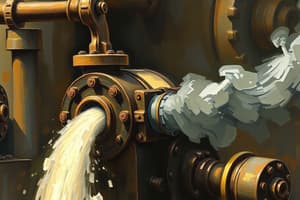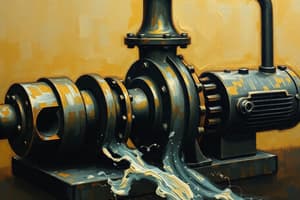Podcast
Questions and Answers
Which type of pump serves as the 'heart' of the energy block system?
Which type of pump serves as the 'heart' of the energy block system?
- Condensate pump
- Cooling water pump
- Feedwater pump (correct)
- Auxiliary pump
What is a key feature of cooling water pumps in an energy block?
What is a key feature of cooling water pumps in an energy block?
- Have a single impeller design
- Operate at low speed
- Draw water from reservoirs or cooling towers (correct)
- Function under high cavitation pressure
What critical temperatures can pumps in an energy block operate under?
What critical temperatures can pumps in an energy block operate under?
- 400–450°C
- 100–150°C
- 200–300°C (correct)
- 50–75°C
How many high-end feedwater pumps typically work in parallel in critical blocks?
How many high-end feedwater pumps typically work in parallel in critical blocks?
What advantage does a double-stream pump have over single-stream pumps?
What advantage does a double-stream pump have over single-stream pumps?
What is the typical operating pressure range for pumps in energy systems?
What is the typical operating pressure range for pumps in energy systems?
What characterizes the flow of fluid in a double-stream pump?
What characterizes the flow of fluid in a double-stream pump?
Which parameter is minimized in a double-stream pump due to its design?
Which parameter is minimized in a double-stream pump due to its design?
What is one of the three main types of losses evaluated to determine the efficiency of a centrifugal pump?
What is one of the three main types of losses evaluated to determine the efficiency of a centrifugal pump?
Which equation describes the energy imparted to the fluid through differences in peripheral speed at the impeller?
Which equation describes the energy imparted to the fluid through differences in peripheral speed at the impeller?
What is the definition of specific speed (ns) in the context of pumps?
What is the definition of specific speed (ns) in the context of pumps?
Which type of pump is typically associated with the highest specific speed?
Which type of pump is typically associated with the highest specific speed?
What is the main function of internal seals in centrifugal pumps?
What is the main function of internal seals in centrifugal pumps?
Which seal type uses interlocking grooves to slow the fluid's escape path?
Which seal type uses interlocking grooves to slow the fluid's escape path?
Which efficiency measure reflects the ratio of useful flow to total flow in a pump?
Which efficiency measure reflects the ratio of useful flow to total flow in a pump?
What happens to pump efficiency if the reactivity is high?
What happens to pump efficiency if the reactivity is high?
What best describes low specific speed (ns) pumps?
What best describes low specific speed (ns) pumps?
What is the impact of fluid resistance and turbulence in the pump casing on efficiency?
What is the impact of fluid resistance and turbulence in the pump casing on efficiency?
Flashcards
Feedwater Pump Function
Feedwater Pump Function
Provides high-pressure water to boilers in power plants, ensuring reliable operation.
Cooling Water Pump Role
Cooling Water Pump Role
Draws water from reservoirs or cooling towers to cool down systems in power plants.
Condensate Pump Conditions
Condensate Pump Conditions
Operates in low-pressure, high-flow environments, with specific design to handle cavitation.
Double-Stream Pump Impellers
Double-Stream Pump Impellers
Signup and view all the flashcards
Double-Stream Pump Advantages
Double-Stream Pump Advantages
Signup and view all the flashcards
Pump Operating Temperature
Pump Operating Temperature
Signup and view all the flashcards
Pump Operating Pressure
Pump Operating Pressure
Signup and view all the flashcards
Axial Force Compensation (Double-Stream)
Axial Force Compensation (Double-Stream)
Signup and view all the flashcards
Centrifugal Pump Function
Centrifugal Pump Function
Signup and view all the flashcards
Mechanical Efficiency
Mechanical Efficiency
Signup and view all the flashcards
Volumetric Efficiency
Volumetric Efficiency
Signup and view all the flashcards
Hydraulic Efficiency
Hydraulic Efficiency
Signup and view all the flashcards
Euler's Equations (First Form)
Euler's Equations (First Form)
Signup and view all the flashcards
Euler's Equations (Second Form)
Euler's Equations (Second Form)
Signup and view all the flashcards
Pump Reactivity
Pump Reactivity
Signup and view all the flashcards
Specific Speed (ns)
Specific Speed (ns)
Signup and view all the flashcards
Low Specific Speed (ns)
Low Specific Speed (ns)
Signup and view all the flashcards
High Specific Speed (ns)
High Specific Speed (ns)
Signup and view all the flashcards
Study Notes
Pump Operation in Energy Blocks
- Pumps in energy blocks (e.g., feedwater, cooling water, condensate) are crucial for system function.
- Each pump type is designed for specific conditions (temperature, pressure, fluid).
- Feedwater Pumps: High-pressure, high-temperature multistage pumps. Two or three pumps often operate in parallel for reliability in critical applications. They operate at 5,000-6,000 rpm and have power outputs up to 40-60 MW.
- Cooling Water Pumps: Large, high-speed axial or diagonal pumps often drawing water from reservoirs or cooling towers.
- Condensate Pumps: Designed for low pressure, high flow, and challenging cavitation (bubble formation) conditions. Specialized construction reduces wear due to cavitation.
- Auxiliary Pumps: Smaller pumps handle tasks like dosing, circulation, and water treatment.
- Operating conditions: 200-300°C temperatures and up to 28 MPa and higher pressures are common. High efficiency and reliability are essential.
- Feedwater Pump Diagram: Imagine a horizontal, cylindrical pump body with internal impeller stages, high-pressure discharge, and a shaft seal to control leakage.
Double-Stream Pump Construction
- Design: Two impellers mounted back-to-back; fluid enters from both sides, exits as a single spiral flow.
- Advantages:
- Compensates for axial forces due to symmetric flow.
- Higher efficiency than single-stream pumps.
- Larger flow capacity due to dual inlets.
- Reduced component wear and mechanical stress.
- Operation: Fluid converges smoothly at the pump's center. Imagine two counter-rotating wheels directing a combined fluid flow outward.
Energy Balance in Centrifugal Pumps
- Efficiency Factors:
- Mechanical Losses: Friction in bearings and couplings.
- Volumetric Losses: Leaks through seals and shaft sleeves.
- Hydraulic Losses: Flow resistance and turbulence in the casing and impeller.
- Efficiency Equations:
- Mechanical Efficiency: Considers power loss in moving parts.
- Volumetric Efficiency: Measures useful flow compared to total flow, accounting for leakage.
- Hydraulic Efficiency: Measures energy transfer from the impeller to the fluid.
- Visualization: Pump performance is often visualized using charts (like Gradewald charts) depicting efficiency curves against flow rates (Q) and specific speed (ns) to understand optimal operation.
Centrifugal Pump Principles
- Function: Centrifugal pumps use rotating impellers to impart kinetic energy to a fluid, converting it into pressure energy as it exits.
- Euler's Equation (First Form): H = (u2^2 / 2g) - (u1^2 / 2g), where u2 and u1 are outlet and inlet impeller peripheral speeds, and g is acceleration due to gravity.
- Euler's Equation (Second Form): H= (1/g) (u2cu2-u1cu1), (where cu is tangential velocity component).
- Pump Reactivity: The proportion of energy converted from kinetic to pressure energy. High reactivity improves efficiency in high-pressure applications.
- Visualization: Imagine water being flung outward by a spinning impeller. Faster impellers and sharper blade angles impart more energy, resulting in greater output.
Specific Speed (ns)
- Definition: Dimensionless number characterizing pump design and performance. Indicates the pump's best applications based on flow and head.
- Formula: ns = n√Q/H^(3/4), where n is pump speed (RPM), Q is flow rate (m³/s), and H is the head (m).
- Pump Types by Specific Speed:
- Low ns (e.g., ~80): Axial or mixed-flow pumps for high flow at low heads.
- Visualization: Low ns pumps move large volumes of fluid at lower heights, while High ns pumps move smaller amounts of fluid to higher elevations.
Pump Type Comparisons Based on Specific Speed
- Double-stream pumps: Highest ns due to dual inlets and wide flow paths, increasing flow rate (Q).
- Single-stage pumps: Moderate ns, suitable for general applications.
- Multistage pumps: Lowest ns, designed for high heads using sequential impellers.
Internal Seals in Centrifugal Pumps
- Purpose: Minimize volumetric losses by reducing fluid leakage.
- Seal Types:
- Shaft Seals (mechanical or packing): Prevent leaks around the rotating shaft.
- Labyrinth Seals: Use interlocking grooves and ridges to increase resistance and reduce leakage.
- Balance Holes: Relieve impeller face pressure by redirecting fluid.
- Technical Solutions: Reduce clearances, use durable and corrosion-resistant materials.
- Visualization: Think of a labyrinth seal as a maze that slows down leaking fluid.
Studying That Suits You
Use AI to generate personalized quizzes and flashcards to suit your learning preferences.




